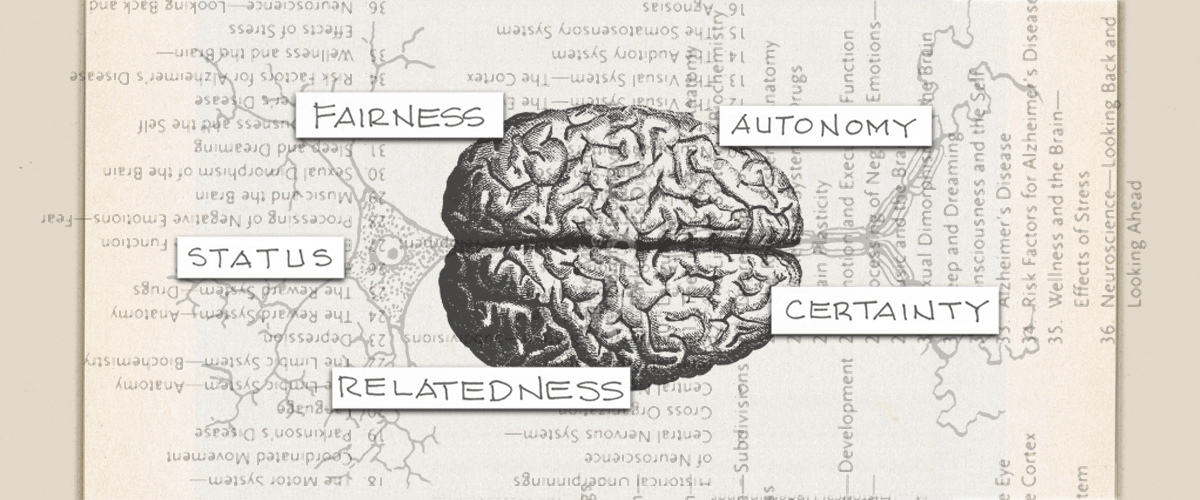Let’s dive beyond ping-pong tables, team huddles and on-site massages to a deeper conversation about employee engagement — namely, its biological underpinnings. Within the brain, how does engagement come into play, and what does that mean for business leaders? To study this, we turned to the work of David Rock, director of the NeuroLeadership Institute. His work explores how to use the findings of brain research within organizations. In our eyes, there is a clear link to an organization’s brand strategy, but more on that later.
Our basic biological wiring
To begin, we must understand the basic nature of our brains. Within our biology, there are two opposing forces at work — our reward response and our threat response. We’re neurologically wired to minimize danger and maximize reward. This holds true not only for basic survival needs, but also for our social behavior and experiences. Whenever we are working and interacting with others, our reward or threat responses can be activated.
So, what factors influence whether the reward or threat response is activated? Rock boils it down to five key drivers — status, certainty, autonomy, relatedness and fairness. Status considers one’s relative importance or seniority. Certainty is linked to one’s relative ability to predict the future or know what is to come. Autonomy considers one’s sense of control and ability to make choices. Relatedness is linked to one’s sense of belonging within a social group. Fairness considers how fair one perceives one’s environment to be. Threat to any one of these drivers activates our threat response, whereas support for any of these drivers activates our reward circuitry.
How engagement fits in
When we look at this through the lens of engagement, Rock notes that employees’ levels of engagement correspond to activation of their reward circuitry when working or thinking about work. On the flip side, disengagement is linked to activation of the brain’s threat circuitry when working or thinking about work. Given this, leaders best engage employees by encouraging the reward response and minimizing the threat response. To do so, corporations must create environments and interactions that support the five drivers.
In some companies, that means debunking uncertainty’s grip through clear communication. Leaders paint highly specific pictures of the future, break bigger projects into bite-sized chunks and transparently articulate rationale during times of change. Other companies focus on feeding employees’ sense of autonomy by letting people choose their hours and workspaces. Oftentimes, they give employees significant decision-making power and let employees design solutions to those problems that impact them. Still other companies limit compensation at the top tiers in order to promote fairness.
Higher purpose as a tool to activate the reward system
Interestingly enough, Rock mentions one way to satisfy all five drivers simultaneously. It is through participation in tasks that one perceives to be socially valuable — that is, efforts that bring some sort of greater good. Why? Rock notes in an article on his “SCARF” model, “You are improving your status in the eyes of yourself and others. You are decreasing uncertainty, by solving some kind of social problem that did not have a solution. You are acting autonomously, making choices instead of complaining about the problem. You are connecting with other people to facilitate change and you are reducing unfairness in the world in some way.”
Eureka! This is precisely why brand strategy matters and why it is important for a company to invest in articulating their brand platform — in particular, their higher purpose. When leaders guide organizations from a clear sense of higher purpose and connect employees’ contributions to that higher purpose, they support the reward response. This dramatically alters employees’ neurological responses in the workplace and increases their engagement. The result is the golden egg of competitive advantage — discretionary effort of your workforce. It also unlocks higher levels of team loyalty and job satisfaction; meanwhile, it reduces costly performance drains like absences and turnover.
It turns out the frequency of this conversation is also important. Leaders are better off running the risk of being a broken record than stating employees’ connection to a higher purpose too few times. Why? Evidently, as we collaborate with others, our biological default is the threat response. It is easily triggered and has more lasting effects than the reward response. Given this, we can assume that the occasional mention can only go so far. Organizations and their leaders need to embed employees’ connection to higher purpose into the everyday conversation of the organization — whether it be memos, manuals, brand stories, collateral or office dialogue. It awakens the desired reward response and the associated levels of positive engagement that ultimately drive business performance.
Turned on employees
Around Baker, we call this “Performance from purpose.” Leaders can expect great things when the reward systems of their employees are activated via connection to a higher purpose. We’ve seen it again and again in our 30 years of working with clients. Engaged employees are capable of more creative problem solving. Instead of worrying or stalling out, they dig deep into their most powerful cognitive capacities to deliver their company’s brand experience. They come up with fresh solutions to streamline customer service. They intuitively use phrases that connect deeply with business partners and customers that build loyalty and satisfying relationships. They proactively address inefficiencies visible from their seats. And the list goes on. Ultimately, these employees move companies forward in ways that magnetize customers and unmistakably impact bottom lines. And seriously who wouldn’t want that? Just a few more reasons why your company should articulate its higher purpose.
Visit David Rock’s website for his full articles, including “Neuroscience of engagement” and “SCARF Model.”
